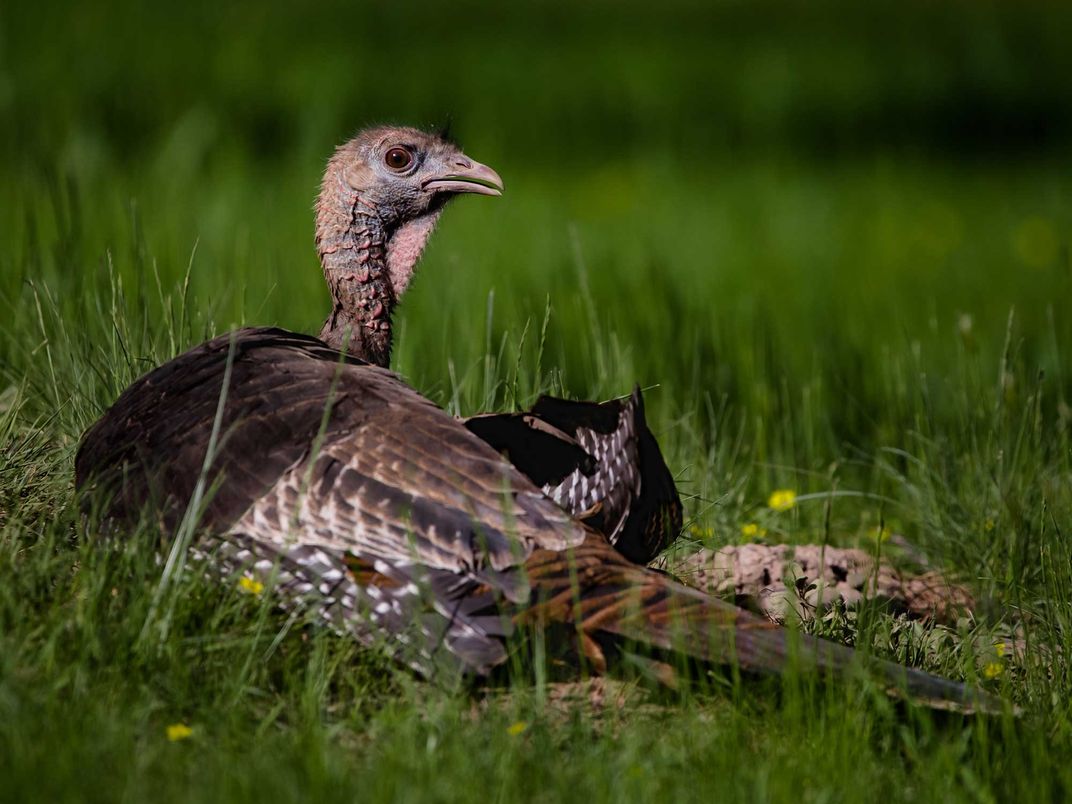View Amazing Photos and Video of a Turkey Dust Bathing
A New York photographer captured stunning footage of this captivating behavior in her backyard
:focal(1533x961:1534x962)/https://tf-cmsv2-smithsonianmag-media.s3.amazonaws.com/filer/97/08/97084f77-adea-4abb-b7cc-be9a0580acc7/04_final_2500_04_wildturkey_carlarhodes.jpg)
When photographer Carla Rhodes first noticed a patch of dust forming in her back yard in New York’s Catskill Mountains, she knew something was up.
“This dirt patch started to grow and I didn't know why,” says Rhodes, who specializes in wildlife conservation photography. She set up a trail camera, which captured a wild female turkey—it lacked the bright red and blue wattle and fanned tail feathers characteristic of males—stopping by her yard every afternoon for a dust bath, a frantic, fluttering affair in which the bird kicked up dirt to maintain her plumage.

Soon after, Rhodes set up a camouflaged hunting blind in her driveway. Armed with her camera and hoping to snap a photograph of the wild turkey in action, Rhodes sat for hours in silence. “One day, I was in there for four hours, and I wouldn't leave because I would think, when I leave, she's going to show up,” says Rhodes.
“My husband would come outside while I was in the blind,” says Rhodes, “and I would call him from my cell phone and be like, “Get back inside—she might show up, you might scare her!”
Finally, the turkey arrived at the patch of dust, and began her ritual of wriggling and frantically flapping in the dirt, tossing clouds of dust into the air around her. Rhodes was thrilled—she’d finally captured the turkey dust bathing, but she moved too quickly and spooked the bird. The next time the turkey showed up, Rhodes was more cautious and snapped more shots.

It might look like a messy business, but bathing in dust and dirt actually helps turkeys get cleaner. Dusting removes pests and parasites and keeps the birds’ skin healthy and feathers from getting matted, which could impede flight. (Yes, turkeys can fly.) Many bird species, from tiny quail to towering ostriches, keep their plumage in top condition by regularly dust bathing.
To sufficiently coat themselves in dust, turkeys flap their wings, sometimes turning over on their back and wriggling in the dirt. By extending their wings, they make sure no feathers go undusted. After thoroughly covering themselves in dust, turkeys preen their feathers with their beaks, which helps clean the features and realign the interlocking feather barbules.
/https://tf-cmsv2-smithsonianmag-media.s3.amazonaws.com/filer/16/4c/164cca55-10ca-4948-a9a5-ceb7488d2457/08_final_2500_08_wildturkey_carlarhodes.jpg)
Rhodes started tracking in a spreadsheet when the turkey visited her yard, noting down the time and temperature to get better a chance to see the bird. Rhodes says she knew that it was the same turkey who kept returning to her yard from similarities in photographs and because of her behavior each time she visited the dust bath.
Rhodes became attached to the bird after hours of observation that she gave the turkey a name: “Della,” a homage to her great aunt whose pet turkey first sparked Rhodes’ love of the birds. She admits naming wild animals might sound silly, but Rhodes sees it as a way to help others see wildlife in more personal, individual ways. In her professional work, she has captured images of everything from red fox kits in New York to endangered greater adjutant storks in India.
/https://tf-cmsv2-smithsonianmag-media.s3.amazonaws.com/filer/39/38/3938fe25-5b6a-45a0-b5fe-4bdf290b108e/10_turkefinal_2500_10_wildturkey_carlarhodes.jpg)
“This is one of my favorite things I've ever photographed,” says Rhodes. She knew other birds dust themselves to maintain their feathers, but never considered that turkeys dust bathe, too. “I had never witnessed that behavior, says Rhodes. “To me, it was just really cool to see that.”
Turkeys begin dusting and preening themselves at just a few days old. Usually, dust bathing is a social activity, though Rhodes says this turkey always visited her yard alone. This may be because Rhodes was photographing Della in late spring, which is breeding season. Females are most likely to be solitary during this time of year, which is when they nest. A female turkey can lay a dozen eggs over a span of two weeks. Rhodes found two eggs near her home, and while neither was alive, she’s is curious to know if they might have been Della’s.
/https://tf-cmsv2-smithsonianmag-media.s3.amazonaws.com/filer/6d/e6/6de6a002-0e90-4202-b391-4ff1deef0b47/06_final_2500_06_wildturkey_carlarhodes.jpg)
In the state of New York, where Rhodes lives, wild turkeys are legally protected as a game species. As a native bird, turkeys fill an important ecological role by dispersing seeds and feeding on insects and small rodents. The birds were once abundant in the state, but farming eliminated their woodland habitat and hunting wiped out the entire population by the 1840s. Around one hundred years later, when a lot of abandoned New York farmland turned back into wild shrub or woodland, the birds returned from nearby Pennsylvania. Nationwide, a similar recovery took place, thanks to ongoing conservation efforts. Now, the State of New York has around 180,000 wild turkeys and about 7 million wild turkeys roam the country.
The entire experience with Della only lasted a few weeks, says Rhodes, and she hasn’t caught a glimpse of the bird since. Rhodes says her friends asked why she was so obsessed with observing this turkey.
“The world was falling apart during this time,” says Rhodes, referring to the Covid-19 pandemic. Photographing the wild turkey, she says, “was just so magical and such a nice distraction.”
/https://tf-cmsv2-smithsonianmag-media.s3.amazonaws.com/accounts/headshot/corryn.png)
/https://tf-cmsv2-smithsonianmag-media.s3.amazonaws.com/accounts/headshot/corryn.png)